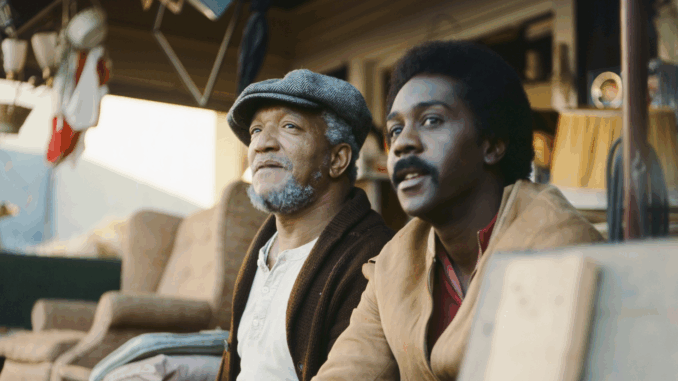
When Redd Foxx uttered his signature line, “You big dummy!” on network television in the early 1970s, he sealed his place as an American comedy icon. As the irascible, junk-dealing patriarch Fred G. Sanford on the groundbreaking sitcom Sanford and Son, Foxx delivered a uniquely black, distinctly urban brand of comedy to an unprecedentedly wide audience.
Yet, for those familiar with the comedian’s work before 1972, the lovable, heart-attack-faking curmudgeon was a drastically cleaned-up version of the man known as the “King of the Party Records.”
Redd Foxx’s journey from the gritty, raunchy stages of the Chitlin’ Circuit to the family-friendly living rooms of primetime America required a dramatic sanitization of his act. The success of Sanford and Son wasn’t just a win for Black representation on TV; it was a masterful, commercially viable rebranding of one of comedy’s most brilliantly “blue” talents.
The “Blue” King of the Chitlin’ Circuit
Before his transformation into Fred Sanford, John Elroy Sanford (Redd Foxx’s birth name) was a legend in the world of adult, underground comedy. His act, honed in black nightclubs from Harlem to Los Angeles—collectively known as the Chitlin’ Circuit—was unapologetically raunchy, profane, and sexually explicit.
His material covered taboo topics like race, sex, and bodily functions with a frankness that would have been unthinkable on mainstream radio or television.
The Party Records Phenomenon
Foxx’s fame was built on more than 50 “party records”—comedy albums that were sold under the counter or in plain brown wrappers due to their explicit nature. These records were the precursor to modern uncensored stand-up specials.
While mainstream audiences were watching censored comics on The Tonight Show, black audiences were listening to Foxx’s albums, such as Laff of the Party and Shed House Fun, in their homes. His comedy was a vital, uninhibited reflection of black working-class life, full of insults, vernacular, and a complete disregard for polite society.
The challenge for legendary TV producer Norman Lear was turning this king of vulgarity into a character palatable for 1970s NBC.
The Sanford and Son Transformation: Fred G. Sanford
When Norman Lear and Bud Yorkin decided to adapt the successful BBC sitcom Steptoe and Son for an American audience, they knew they needed a commanding star. Foxx, whom they saw performing in a Las Vegas nightclub, was the perfect fit—but his act needed to be surgically scrubbed.
1. The Cleansing of the Profanity
The most obvious change was the removal of all profanity and sexual content. The genius of Sanford and Son was how it allowed Foxx to retain his acerbic delivery and timing without the “blue” material.
- Insults Replaced Obscenity: The insults Fred hurled at his son, Lamont (“You big dummy!”) and his sister-in-law, Aunt Esther (“Fish-eye!”), were vicious yet largely harmless, replacing the graphic language of his nightclub act.
- Heart Attacks Replace Sexual Jabs: Fred’s signature fake heart attacks (“I’m coming, Elizabeth! This is the big one!”) became the show’s running gag, a visual and verbal joke that was hysterical but entirely wholesome.
2. The Shift from Bawdy to Bigoted
In his stand-up, Foxx satirized sex and relationships. In Sanford and Son, the satire was redirected toward social and racial prejudice.
Fred Sanford was established as a grumpy, narrow-minded widower living in the Watts neighborhood of Los Angeles. The comedy came from his overt, but ultimately shallow, bigotry towards white people (represented by his police friend, Hoppy), Puerto Ricans (his neighbor, Julio), and even Asian Americans (Ah Chew).
This comedic device, similar to the one employed in Lear’s All in the Family, allowed the show to address racism and cultural divides through humor, making it feel edgy and relevant, yet still within the confines of network TV.
3. Retaining the “Authenticity” through Casting
Despite the content sanitization, Foxx fought hard to keep the show’s spirit authentic by insisting on the casting of his old Chitlin’ Circuit colleagues.
- LaWanda Page (Aunt Esther): Foxx personally lobbied for Page, a fellow “blue” comic, to play his Bible-thumping, finger-wagging foil. The legendary comic chemistry between the two gave the sitcom an unparalleled edge and grounding in the authentic black comedic tradition.
- The Supporting Cast: Other friends from the circuit, like Slappy White and Don Bexley (Bubba), appeared, ensuring that even with cleaned-up scripts, the show was infused with the natural rhythm and comedic style of veteran black performers.
The Legacy of the Clean-Up
The success of Sanford and Son was immediate and overwhelming. It instantly became one of the highest-rated shows on television, demonstrating that a series with a predominantly Black cast could be a massive mainstream hit.
- Mainstream Success: The show proved Redd Foxx had the range to transcend his “blue” reputation and become a universally beloved comedy star.
- Paving the Way: By making Foxx’s persona palatable, the show opened the door for other Black-led sitcoms like Good Times and The Jeffersons, permanently diversifying the television landscape.
- The Eternal Tension: The comedy icon spent his entire career in the tension between his public persona (Fred Sanford) and his private, artistic self (Redd Foxx, the raunchy stand-up). Even while at the peak of TV fame, Foxx would often chafe at the constraints of network television, battling for better contracts and higher pay that reflected his massive star power. His on-set antics and frequent, legendary walkouts were a sign that the real Redd Foxx was still fighting against the imposed politeness of primetime.
Ultimately, Redd Foxx gave up his raunch for reach. By allowing Norman Lear to clean up his act, he became a true television pioneer, forever cementing the image of Fred G. Sanford as a flawed, frustrating, yet profoundly funny American patriarch. Without the sanitization, there would have been no primetime icon—only the uncensored legend of the party records.
